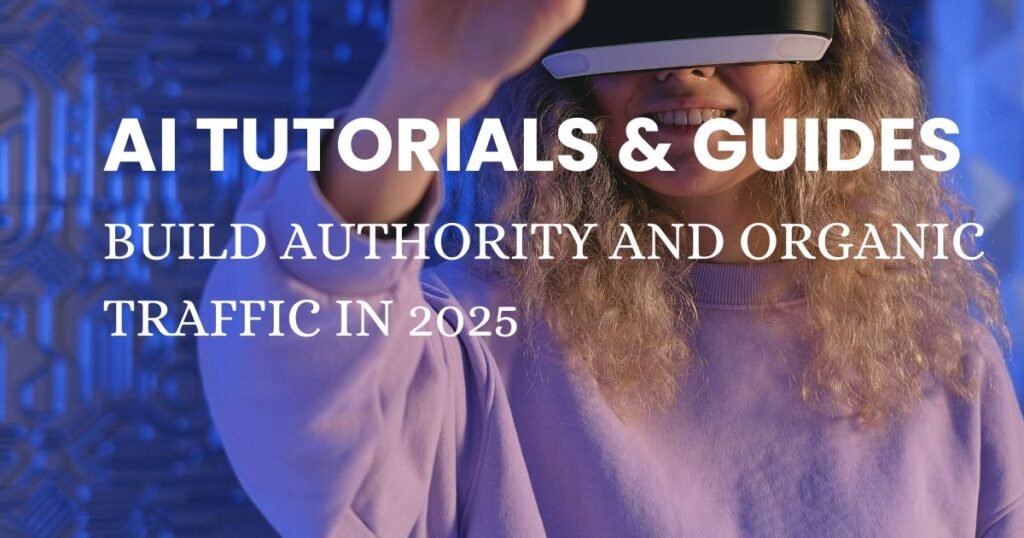
The AI world moves fast—and so do the people trying to learn it. Whether your audience is developers, marketers, writers, or students, there’s one type of content that consistently builds authority, drives organic traffic, and keeps readers coming back: step-by-step tutorials and practical guides.
At OpenAICircle.com, we believe tutorials aren’t just how-to posts—they’re trust builders. They show that your blog isn’t here to chase clicks, but to teach, share knowledge, and help people get real results.
In this blog, we’ll explore why AI tutorials are powerful in 2025, what makes them rank on Google, and how to write them so they’re clear, useful, and engaging.
1. Why AI Tutorials Work So Well in 2025
Let’s start with the basics: why do tutorials matter?
- High search intent: People Googling “how to fine-tune an AI model” or “guide to AI prompt engineering” want answers, not theory.
- Long-tail keywords: Tutorials naturally target detailed queries like “step-by-step guide to AI image generation” which are easier to rank for.
- Trust & authority: Teaching something complex positions your blog as credible.
- Shareability: Clear guides often get shared on forums, social media, and Slack groups.
Example: A guide like “How to automate content research with AI” doesn’t just bring traffic—it brings the right traffic: readers who value depth over hype.
2. Choosing the Right Tutorial Topics
Not every topic works equally well. Aim for:
- Problems your audience actively faces.
- Workflows where AI clearly saves time.
- Topics with medium search volume but low competition.
How to find ideas:
- Check what people ask in AI forums and communities.
- Use tools like Google’s “People Also Ask” or AnswerThePublic.
- Analyze your site’s search queries (via Search Console).
Tip: Avoid brand-heavy topics (like specific tools) to keep ranking stable as tools change.
3. Structuring an Effective AI Tutorial
Great tutorials balance clarity, depth, and usability. Here’s a reliable structure:
- Clear title: “Step-by-Step Guide to AI-Based Keyword Research (2025)”
- Introduction: Why it matters, who it’s for.
- Prerequisites: Tools, data, or skills needed.
- Step-by-step instructions: Use numbered lists, visuals, or screenshots.
- Examples: Show real use cases or results.
- Common mistakes / FAQs: Address them directly.
- Conclusion: Summarize, link to related tutorials.
- CTA: Encourage comments, shares, or newsletter signups.
SEO tip: Add a table of contents (with jump links) for longer guides—helps both readers and search engines.
4. Writing Style: Human-First, Jargon-Second
AI topics can get technical fast. But remember: tutorials are for people, not machines.
- Use plain language.
- Explain terms the first time you use them.
- Keep sentences and paragraphs short.
- Break up walls of text with visuals.
Example: Instead of “leveraging NLP transformers for content generation”, say:
“We’ll use a language model to draft posts automatically.”
5. Adding Visuals and Media
Visuals help tutorials rank and keep people engaged:
- Screenshots showing each step.
- Flowcharts to explain processes.
- Short videos or GIFs for tricky parts.
- Highlight boxes for tips, warnings, or extra context.
Pro tip: Optimize image alt text and filenames for SEO (e.g., ai-keyword-guide-step1.png).
6. Keeping Tutorials Up to Date
AI evolves quickly; old tutorials can lose traffic. Build an update process:
- Review popular guides every 6–12 months.
- Track tool updates and adjust content.
- Add a “last updated” date to signal freshness to Google and readers.
SEO boost: Updated tutorials often get a ranking bump.
7. Linking Strategies: Internal and External
Good tutorials rarely stand alone:
- Internal links: Connect to related guides or case studies.
- External links: Cite reputable sources or original research.
This:
- Helps readers explore.
- Boosts session time and reduces bounce rate.
- Strengthens your site’s topical authority.
8. Promoting Tutorials After Publishing
Writing isn’t enough—promotion matters:
- Share in AI communities (Reddit, Discord, LinkedIn groups).
- Turn key steps into Twitter/X threads or LinkedIn posts.
- Repurpose as short explainer videos or carousels.
- Mention the guide in your newsletter.
Content flywheel: Tutorials → Social snippets → Newsletter → More traffic → More backlinks.
9. Measuring Success: What to Track
Beyond pageviews, watch:
- Time on page: Longer = readers find value.
- Scroll depth: Are people reaching the end?
- Comments or questions: Shows engagement.
- Backlinks: Signal authority.
- Organic keyword growth: Use tools to track.
10. Real-World Tutorial Ideas for 2025
To get started, consider these high-value, brand-free ideas:
- “How to create AI-powered data visualizations”
- “Prompt engineering basics for writers and designers”
- “Automating SEO audits with AI tools”
- “Building AI-assisted chatbots for customer support”
- “Using AI to analyze survey data”
These target real-world problems—and people search for them.
11. Avoiding Common Mistakes
Even strong blogs can miss the mark:
- Skipping context: Explain why each step matters.
- Overusing jargon: Alienates beginners.
- Ignoring mobile design: Many read tutorials on phones.
- No clear CTA: Don’t leave readers hanging.
12. Beyond Traffic: Building Community
Tutorials don’t just bring traffic—they start conversations.
- Ask readers to share how they used the tutorial.
- Feature user questions or improvements in updates.
- Host Q&A sessions based on popular guides.
Result: loyal followers, user-generated content, and fresh SEO signals.
13. The Future: AI-Enhanced Tutorials
In the next few years, tutorials will get smarter:
- Personalized guides based on user skill level.
- AI-generated summaries at the top.
- Interactive steps where readers input data and see live results.
But the best tutorials will still reflect human empathy: anticipating confusion, adding encouragement, and explaining why choices matter.
Conclusion: Teaching as a Growth Strategy
In 2025, the blogs that grow aren’t the loudest—they’re the most helpful. Detailed AI tutorials and guides:
- Build trust.
- Earn backlinks.
- Keep visitors longer.
- Turn readers into community members.
If your goal is organic, sustainable growth, teaching what you know is still your best strategy.
